| |
|
|
|
|
English Family Quick Links
|
|
|
|

|
|
|
|
|
Family 15: Royal Mare
 |
VIEW DESCENT CHART
The General Stud Book lists (Grey) Whynot and her progeny in its section of earliest broodmares, noting she was "Got by Old Whynot (son of the Fenwick Barb), her dam a Royal Mare." In fact, in most of the old scribed images of early racehorses, such as the Carlisle Gelding, it is (Grey) Whynot herself who is referred to as "...a Royal Mare of the Why-not Kind."
As noted in other sections of Heritage, the appellation "royal mare" was a name used to describe a number of mares in the Sedbury stud of the D'Arcy family (both father and son, named James), and occasionally of mares derived from the Royal Stud at Tutbury (dispersed by Cromwell) or later, at Hampton Court. Most historians agree that the use of the term "royal" for at least some of these mares derives from the 1661 agreement between James D'Arcy (the elder), the king's Master of the Horse, and Charles II, for D'Arcy to provide colts to the king from mares of his (D'Arcy's) "own breed." The "names" of mares during this period were often passed from generation to generation, without change, except, perhaps for adding the prefix "Old" to the dam of a mare by the same name, or "Young" for a daughter. Thus, the term "royal" in a mare's name during the latter half of the seventeenth century, generally indicated a mare was probably a tail-female descendent of a mare from the pre-Cromwellian studs, or a mare of unknown tail-female descent--but of the "D'Arcy breed" used to produce foals as part of the agreement between Charles II and James D'Arcy the elder.
(Old) Whynot, a famous race horse who ran in the early 1680s at Newmarket, was bred by the owner of his sire, the Fenwick Barb. He may have passed into the hands of Mr. Wilkinson of Boroughbridge, North Yorkshire; he is referred to as "Wilkinson's Whynot," in an early contemporary pedigree, and Wilkinson later had a mare by him, second dam of Young (Smales') Childers (1726), and possibly the Why Not mare, taproot of Family 62.
The General Stud Book shows this family was established by Captain Rider, whose stud was near Whittlebury, Northamptonshire. Rider had long been associated with the turf, having run and won with his "French horse" in 1782, against the King's horse, Cork, in a match at Newmarket. Later in the decade, he was associated with the Earl of Rutland's running horses, and in the 1790s he sold two horses to the Royal stud.
There are four offspring attributed to (Grey) Whynot in the GSB, two highly significant to the development of early thoroughbreds. It also notes that "Either Grey Whynot, or a sister to her, bred also a filly by Bethell's Castaway, dam of a filly by Dyer's Dimple, dam of a Crab mare, dam of Charlotte by Blank." The convention, not necessarily accurate, in pedigree charts is to show (Grey) Whynot and her sister, referred to as Whynot mare, as two separate mares. (Grey) Whynot was owned by Rider, and he bred the four foals listed in the G.S.B, three of them by his stallion, the St. Victor Barb, brought from France:
The stallion "...Sufficiently distinguished to Sportsmen by the style of ye Bald Galloway," by the St. Victor Barb. He was in the stud at least between 1712 and 1725, and got a number of racehorses, mostly of small stature, like himself--son (Old) Cartouch was reported to be less than 14 hands. His daughters included Old Lady (Family 17); Roxana and her sister, Goldenlocks, both racehorses and dams of colts important to the breed; and Grey Robinson, the dam of Regulus.
Cupid, by the St. Victor Barb, a colt--racehorse.
Points, by the St. Victor Barb, a mare, sold to Tregonwell Frampton and run at Newmarket. In the stud this mare produced a 1715 (or 1721, according to Pick) filly, Flying Whigg, by William's Woodstock Arabian. Contemporary records of this line indicate Flying Whigg was owned by a Mr. Ovington, whose name appears as a breeder of several moderate horses, but the General Stud Book says she was bred by the Earl of Godolphin. In any case, she produced six foals, bred by Leonard Hartley of Yorkshire, two of whom, The Little Hartley Mare (Amorett) and the Large Hartley Mare (Sachrissa) were purchased for the Godolphin stud in 1733 and went on to produce the foals which are largely responsible for this family's early fame.
Unnamed Mare, by Leedes. Produced a daughter by "Lord Godolphin's Dumplin," although no such mare or stallion is identificable in his stud book. This mare was the fourth dam of Sportsman, who won a number of races between 1752 and 1754.
Of the other Whynot Mare line, not much can be determined of its early breeding until the third generation, the mare by Crab, who was, apparently, in the stud of a Mr. Stewart for a few years. The Wryneck branch of this family (15-b) extends from this line.
With the discovery of the Earl of Godolphin's studbook in the early part of the 20th century, it was determined that the General Stud Book had erroneously attributed the famous American mare, Selima, to this family, as a daughter of The Large Hartley Mare (Sachrissa), an error also perpetuated in the American Stud Book. The Godolphin stud book showed her to be a daughter of Shireborn, the Hobgoblin mare in the Earl's stud. Consequently, Selima belongs to Family 21, rather than Family 15, and the pop-up reference chart and material on this page is adjusted to reflect that. For more information on Selima, see this article, published in the Thoroughbred Times.
|
Royal Mare's
Known Produce:
(Grey) Whynot by (Old) Whynot. Dam of
c. Bald Galloway by St. Victor's Barb.
c. Cupid by St. Victor's Barb.
f. Points by St. Victor's Barb. Dam of
f.Flying Whigg by (Williams') Woodstock Arabian
c. by (Williams') White Turk
f. by Leedes. Dam of
f. by Dumpling
Whynot by (Old) Whynot. Dam of
f. by Bethell's Castaway. Dam of
f. by Dyer's Dimple
|
|
|
FAMILY #15 NOTABLE DESCENDANTS
|
|
Family #15 Oaks Winners
|
|
|
|
 |
|
|
Theophania |
|
1803 THEOPHANIA b.f. 1800
(Delpini - Violet) |
| |
Family #15 Derby Winners
|
|
|
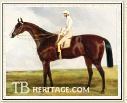 |
 |
|
Attila |
Harvester |
|
1791 EAGER b.c. 1788
(Florizel - mare by Matchem) |
1842 ATTILA ch.c. 1839
(Colwick - Progress) |
1884 HARVESTER br.c. 1881
(Sterling - Wheatear) |
|
|
Family #15 St. Leger Winners
|
|
|
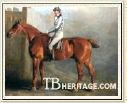 |
 |
|
Soothsayer |
Jerry |
|
1779 TOMMY ch.c. 1776
(Wildair - mare by Syphon) |
|
1798 SYMMETRY gr.c. 1795
(Delpini - Violet) |
1808 PETRONIUS b.c. 1805
(Sir Peter Teazle - Louisa) |
1811 SOOTHSAYER ch.c. 1808
(Sorcerer - Golden Locks) |
1824 JERRY bl.c. 1821
(Smolensko - Louisa) |
|
|
Family #15 Other Family Members
|
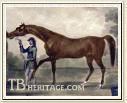 |
|
Babraham |
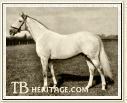 |
|
Baytown |
 |
|
Cloverbrook |
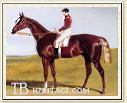 |
|
Hornsea |
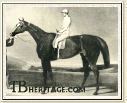 |
|
Miss Elis |
 |
|
Nancy |
 |
|
Shakespeare |
 |
|
Sweetbriar |
 |
|
Wolf's Crag |
|
Babraham b.c.
1738
(Godolphin Arabian - Sachrissa)
Best known of Sachrissa's (Large Hartley Mare) offspring, he won races in the mid 1740s; at stud he got Derby winner Aimwell, the top racehorse Cardinal Puff, the top racemare Molly Long Legs, and a number of productive daughters. Sachrissa also produced Mogul (1735), the sire of Whistlejacket, and Hartley's Roan Stallion.
|
Baytown gr. c. 1925
(Achtoi - Princess Herodias)
A contender for the Irish Triple Crown, he missed by running second in the Irish St. Leger. Sturdy and sound, he won 10 of his 32 races, including the Caledonian Hunt Cup and the Kempton Park Bendigo Handicap, and placed second 11 times. His main contributon to the breed was through his grey daughter, Kong, herself a tough handicapper who won and placed in several stakes and handicaps in Great Britain, and who produced the good sprinter Grey Sovereign, twice leading sire of juveniles in England, and the unbeaten Champion three year old Nimbus, winner of the Epsom Derby and the 2,000 Guineas, who was not particularly successful at stud. |
Cloverbrook 1874
(Vauxhall - Maudina)
Bred and owned by E.A. Clabaugh, he won two legs of the American Triple Crown -- the Preakness Stakes, and the Belmont Stakes, beating the Kentucky Derby winner Baden-Baden. He did not start in the Derby. He did not breed on.
|
|
Hornsea ch.c. 1832
(Velocipede - Mare by Cerebus)
A good winner of the late 1830s, running in top class company. His wins included the Newcastle St. Leger of 1835, the 100 guineas King's Plate at York, the Heaton Park St. Leger, the Goodwood Cup (1836), the Surrey and Middlesex Stakes and the King's Plate at Egham, The Cup at Newmarket (1836) and the King's Plate at Newmarket (1836); he placed second to the top race filly Queen of Trumps in the Doncaster St. Leger, and second in the Doncaster Cup behind Touchstone. He was first raced by his breeder, William Richardson, and then sold to Lord Chesterfield for 1,800 guineas after his placing in the St. Leger. He was retired to stud at Bretby, where he got some good daughters. One, Lady Lurewell, is tail-female ancestress of Black Duchess, dam of Bay Ronald and Black Cherry. Another, Stitch, was second dam of La Toucques, the leader of her generation in France. |
Jack Horner ch.g. 1917
(Cyllius - Melton's Guide)
Began his working career as a hunter, later tried as a steeplechaser, proving to be erratic in his jumping until 1925, when he placed seventh in the Grand National at Aintree; the following year he won it. He broke down in 1927, and was sent to America for retirement, by his owner, Charles Schwartz. His fourth dam, Thalia, was a good racemare, who produced the successful Irish jumper sire, Play Actor.
|
Miss Elis ch.f. 1842
(Stockport - Varia)
A good, but erratic, racemare, who ran for four years, suffering several changes of ownership in claiming races. Her best wins at 3 were the Goodwood Stakes and the Cup at Kitchener, coming in third in the St. Leger, won by The Libel. At 4 she won a Queen's Plate for mares at Newmarket and the Cup Stakes at Bibury. At 5 she won the Hampshire Stakes at Winchester and retired at the end of the season. |
Nancy b.f. 1848
(Pompey - Hawise)
Top racemare of the 1850s, she was bred by M. Baxter and sold T. Lister who resold her, at age 3, to Mr. Martinson of Hull. As a juvenile she ran third twice, and then won the Two Year Old Stakes at Northallerton in a canter. Lister repurchased her, running her for her first few races of 1851, then sold her back to Mr. Martinson. Among her wins at age 3 -- often against colts and older horses -- were the Chester Cup, Goodwood Cup, the North Derby, the Great Ebor Handicap, the Great Yorkshire Stakes, the York Cup (beating Voltigeur), and a Queen's Plate at Richmond over 2 miles, which she won by twenty lengths. That fall, she slipped in training and sprained her off hind leg, and never regained her form, although her connections ran her until 1855, unplaced in every race. A game mare to the end, she broke her leg in the running for the 1855 Chester Cup, and was destroyed. |
Skylark b.c. 1873
(King Tom - Wheat-Ear)
His best win was the Ascot Gold Vase; in the stud his major contribution was his daughter, Warble, whose daughter, Maid of the Mint, produced Spearmint (Epsom Derby, Grand Prix de Paris, sire of Plucky Liege, Spion Kop and other good horses), and who, through another daughter, Honey Bird (Cambridgeshire Stakes), was ancestress of the speedy American filly Ruddy Light. |
Shakespeare ch.c. 1746
(Hobgoblin - Amorett)
One of a series of excellent racehorses out of Amorett, the Little Hartley Mare, produced after her sale from the Earl of Godolphin's stud. He ran for five years at Newmarket, Lincoln, Guildford and elsewhere, winning several King's Plates. His best offspring were fillies, including Titania, dam of Satellite; the dam of Sweetbriar (see below); and Diana, the dam of Acteon. His dam, Amorett (Little Hartley Mare) also produced the racehorses Tortoise (1737); Timmer (1744); Midas (1746); Slouch (1747); Blank, who established his own branch of the Godolphin Arabian sire line; Old England (Slugg, 1741), who ran in Ireland and got some good racehorses and broodmares there; Janus (1738), sire of the important American sire (Little) Janus (also called Stiff Dick); and Miss Meredith, a good producer who established a long-lived branch. |
Soothsayer ch. c. 1808
(Sorcerer - Golden Locks)
Good runner at age 3, placing second in the Peregrine Stakes, then winning the Doncaster Stakes, and the Doncaster St. Leger, beating twenty-one other horses in the latter; later wins included some handicaps and a match race for 500 guineas against Phantom in 1813, his last race. Leading sire in Great Britain in 1819, he got, among others, Interpreter (2,000 Guineas); Miracle (July Stakes at Newmarket); Tiresias (Derby winner of 1819); Filagree, a racemare and later dam of Cobweb, Trampoline and Riddlesworth; and a number of other good producers. |
Sweetbriar ch.c. 1769
(Syphon - Mare by Shakespeare)
Unbeaten in his two years of racing, ages 4 and 5, winning several matches and sweeps at Newmarket. Successful stallion, sire of Derby winner Assassin, Racer, brothers Discord and Doubtful, and others. |
Violet f. 1787
(Shark - Mare by Syphon)
Excellent broodmare from this family, in the stud of Sir Thomas Gascoigne, her foals included his St. Leger winner Symmetry, his Oaks winner Theophania, Thomasina, a mare "who won nearly every race she started for," and Lennox and Tooee, both good racing colts. |
Wolf's Crag br. c. 1890
(Barcaldine - Lucy Ashton)
His name, following in the tradition of his dam and grandam, derived from Sir Walter Scott's Bride of Lammermoor. Won four races with a total value of £2,220, his best success the Lincolnshire Handicap at 3 years, in which he beat two other horses. He was a surprising success as a sire, getting a number of useful horses, including Cinderello (Lincolnshire Handicap), Dumbarton Castle (Stewards' Cup), the unbeaten two year old Blacksmith, and the mare St. Louvaine, dam of Louviers (Ascot New Stakes, Coventry Stakes and sire of German champion and top sire Landgraf), and Louvois (2,000 Guineas, Prince of Wales' Stakes, second Derby, sire of 2,000 Guineas winner St. Louis and the great broodmare Harpsichord). |
|
|
|
|
|
|
|

